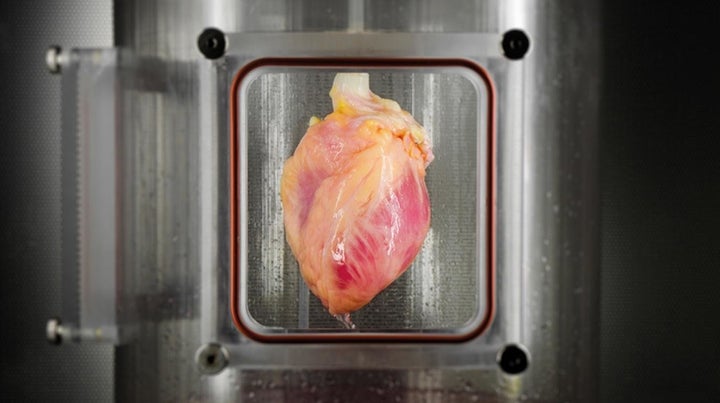
Researchers at Massachusetts General Hospital in Boston have taken a big first step toward growing human hearts in a lab, which could possibly put an end to the national organ donation crisis.
The scientists stripped donor hearts of any cells that might cause recipients to reject them and then used stem cells to rebuild the tissue.
A study detailing the process sheds light on several key elements of bioengineering human heart muscle, said Dr. Harald C. Ott. He is an assistant professor in surgery at the hospital and a senior author of the study, which was published in the journal Circulation Research in the fall.
"While limited in force, these were the first (tiny) beats of a newly formed, human stem cell derived heart," Ott wrote last week in an email to The Huffington Post.
Scientists still have a ways to go until they can bioengineer whole functional hearts for patients, he added. Ideally, however, they one day might be able to grow an entire organ using the donee's own cells and tissue.
"As with many developments, time is a factor determined by funding, man and brain power," Ott said. "Our study shows that it is in theory possible, but much work remains to be done. As a first step, I do believe that parts of human hearts will become available sooner than whole heart grafts, and we are actively pursuing this option."
Having that option would be life-saving, as there are 4,153 people across the U.S. who need a heart transplant -- and last year, about 402 people died while on the waiting list for one, according to the United Network for Organ Sharing.
“Sometime in the future we will be able to grow hearts, or at least heart tissue to offset the bottleneck."”
- Biologist Dr. Young-sup Yoon
The study involved 73 human hearts that had been donated through the New England Organ Bank. They weren't suitable for transplantation but could be used for research purposes. The scientists used a detergent solution to strip away the hearts' incompatible cells, leaving behind cardiac "scaffolds."
Next, they turned adult skin cells into pluripotent stem cells, which can be transformed into any other cell found in the human body. The researchers induced the pluripotent cells to become cardiac muscle cells and then repopulated the remaining "scaffolds" with the new cells.
They mounted the hearts in an automated bioreactor system (see photo above) that added nutrients to the organs and applied certain stressors to them -- conditions similar to those experienced by a real, living heart. After 14 days, the hearts resembled normal, immature organs and even responded to electrical stimulation.
Dr. Jacques Guyette, a postdoctoral research fellow at the hospital and lead author of the study, said in a statement that the researchers are planning to improve their methods even more.
"Regenerating a whole heart is most certainly a long-term goal that is several years away, so we are currently working on engineering a functional myocardial patch that could replace cardiac tissue damaged due [to] a heart attack or heart failure," he said.
This technique is one of several being studied in hopes of someday providing patients with transplants that won't be rejected, Fast Company reported. It also validates the feasibility of using human pluripotent stem cells in the future, said Dr. Young-sup Yoon, director of stem cell biology at the Emory University School of Medicine.
"Most definitely, sometime in the future we will be able to grow hearts, or at least heart tissue to offset the bottleneck," Yoon, who was not involved in the study, told HuffPost. "This study certainly provides a direction which may lead to such a future. ... From this, we can identify that developing newer biomaterials would greatly enhance the viability of the approach, and needs further investigation."
Related Coverage:

